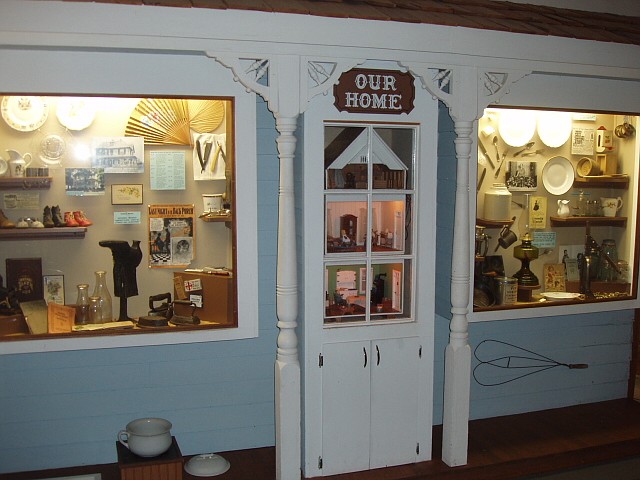By RICHARD SCHROEDER
Museum Chairman
The museum exhibit, Our Home, is set as a front porch which was a standard feature of homes in the early 1900's - before air conditioning -- when a glass of lemonade and a visit by neighbors was the standard evening for many people. The display contains items commonly found in these homes. Nearly all of the items show durability which was the most valued feature of home and kitchen items. Nothing was simply thrown away when it was broken -- it was repaired. The Hill Hardware in California would always attempt to repair something before offering to sell you a new one. Repair kits were sold for many items.
In the center of this broad exhibit is a miniature home as it might have been in the early 1900's. Grandmother is knitting and telling her granddaughter stories while grandfather sits at the kitchen table reading his Bible while the blackberry pie cools. The sink has a hand pump and waste water was caught in a bucket and could be used to settle the dust or slosh the porch. Braided rugs adorned the floors. The "sad irons" were heated on the wood stove. The new brass bed replaces the old walnut bed now stored in the attic.
The clippers and razors remind us that haircuts were done at home and without electricity. A worn ladies shoe is shown being repaired at home. The exhibit shows an ad for a mouse trap that ladies could manage. Vegetables grown in the home garden and canned was an important chore. Mrs. Tising, from High Point, is shown with her many ribbons from the fair for her canned goods. Some people bottled their homemade root beer and ketchup.
Homemade soap made from wood ashes and lye was used for laundry and bathing. On Saturday nights water was hand pumped from a well or cistern and heated on a wood stove. Bathing was done in the kitchen in winter where the wood cook stove kept the room warm. The youngest, or cleanest, were bathed first and the rest shared the bath water. Water was scarce in dry years and never wasted. Under the display is the chamber pot that was kept under each bed. It was a long, dark trip to the out house at night. A rug beater or a broom kept the rugs clean and clothes were washed on a wash board. There was no electricity for a vacuum sweeper or a washing machine. A coal-oil lamp was the common source of lighting before rural electric service began as one of the New Deal programs of the F.D.R. era in the 1930's.
Near this display is a smaller exhibit that features many kinds of needlework, a treadle sewing machine and a hand cranked wall telephone -- all standard home appliances. In this display is an obituary of a woman who's claim to fame was her talent for sewing and mending.
There are quotations in the displays from the W. W. Miller Farm Journal that describes the daily chores and community life as experienced by a family near McGirk in 1915. This delightful journal is for sale at the genealogy library at the Cultural Heritage Center.

